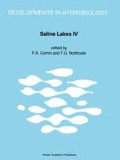Abstract
We have conducted a preliminary survey of analyzed surface sediment samples from approximately twenty lakes in Australia for their Fe, Cu, Pb and Zn concentrations. In addition lake sediments from the gold mining areas of Western Australia (WA) were analyzed for Ag, and samples from NW Victoria were analyzed for Mn, Ni, Co, Cr and V. These lakes are discharge zones for regional and/or local saline groundwaters. The groundwaters entering many of these lakes have very low pH’s (pH 3–4) and contain extremely high dissolved Fe concentrations. These low pH waters may also contain high concentrations of trace metals and radionuclides from the 238U decay series.
The WA data yield the following information: (1) with the possible exceptions of Ag, these sediments show no trace metal enrichments above average shale/sandstone values; (2) some lakes draining Archean gold mining terrain have high Ag concentrations; (3) the highest Pb concentrations are in a lake where acid groundwater input occurs; and (4) the acid mineral alunite does not appear to be a metal ‘sink’ in the acid groundwater lakes.
In the two NW Victorian lakes, the sulfidic zone below the cyanobacterial mat is enriched above by about 100 × for Cu, 30 × for Zn and 78 × for Pb compared to the sediments outside the discharge zone. The Victorian data set indicates a correlation between Cu and Zn and also between Cr and Ni concentrations. Three generations of ‘ironstone-like’ sediments were also analyzed. These iron-oxide rich sediments gained Cu but lost Co with age and maturation. The Mn concentration appears to be important in controlling the Zn and Cu in these ‘ironstones’. It appears from our data that neither the oxide-rich nor the acid-rich authigenic sediment phases are major sinks for groundwater metal in these systems.
Access this chapter
Tax calculation will be finalised at checkout
Purchases are for personal use only
Preview
Unable to display preview. Download preview PDF.
References
Bettenay, E., A. V. Blackmore & F.J. Hingston, 1964. Aspects of the hydrologic cycle and related salinity in the Belka Valley, Western Australia. Aust. J. Soil Res. 2: 187–210.
Bowler, J. M. & J. T. Teller, 1986. Quaternary evaporites and hydrological changes, Lake Tyrrell, north-west Victoria. Aust. J. Earth Sci., 33: 43–63.
Cronan, D. S., 1976. Manganese nodules and other ferro-manganese oxide deposits. In Chemical Oceanography, Vol. 5. Academic Press, New York, p. 217–265.
DeDeckker, P., 1988. Biological and sedimentary facies of Australian salt lakes. Palaeogeo. Palaeoclim. Palaeoecol. 62: 237–270.
Drever, J. I., 1974. Geochemical model for the origin of Pre-cambrian banded iron formations. Geol. Soc. Am. Bull. 85: 1099–1106.
Förstner, U., 1977. Mineralogy and geochemistry of sediments in arid lakes of Australia. Geol. Rundsch. 66: 146–156.
Francois, L. M., 1986. Extensive deposition of banded iron formations was possible without photosynthesis. Nature 320: 352–354.
Gaudette, H. E. & W. B. Lyons, 1984. Trace metal concentrations in modern marine sabkha sediments. In Microbial Mats: Stromatolites, A.R. Liss, Inc., New York, p. 425–434.
Kimberley, M. M., 1978. Paleoenvironmental classification of iron formations. Econ. Geol. 73: 215–229.
Kiss, E., 1973. Spectrophotometric determination of cobalt in silicates and meterorites. Analyt. Chim. Acta. 66: 385–396.
Kiss, E., 1975a. Selective spectrophotometric determination of vanadium in silicates with a new pyridylazophenol in the presence of hydrogen peroxide. 7: 205–221.
Kiss, E., 1975b. Selective spectrophotometric determination of cobalt in silicates and meteorites. Analyt. Chim Acta. 77: 320–323.
Long, D. T., W. B. Lyons & H. E. Gaudette, 1985. Trace metal concentrations in modern marine sabkhas. Chem. Geol. 53: 185–189.
Macumber, P. B., 1983. Interactions between groundwater and surface systems in northern Victoria. Ph.D. dissertation. University of Melbourne, Australia. 506 pp.
Mann, A. W., 1983. Hydrogeochemistry and weathering on the Yilgarn Block, Western Australia — ferrolysis and heavy metals in continental brines. Geochim. Cosmochim. Acta 47: 181–190.
Mann, A. W., 1984. Mobility of gold and silver in lateritic weathering profiles: Some observations from Western Australia. Econ. Geol. 79: 38–49.
Mason, B., 1966. Principles of Geochemistry, 3rd edition. J. Wiley & Sons. New York, 329 pp.
Murray, J. W. & G. Gill, 1978. The geochemistry of iron in Puget Sound. Geochim. Cosmochim. Acta 42: 9–20.
Tessier, A., F. Rapin & R. Carignan, 1985. Trace metals in oxic lake sediments: possible adsorption onto iron oxyhy-droxides. Geochim. Cosmochim. Acta 49: 183–194.
Thornber, M. R., E. Bettenay & G. R. Russell, 1987. A mechanism of aluminosilicate cementation to form a hardpan. Geochim. Cosmochim. Acta 51: 2303–2310.
Walker, J. C. G., 1984. Suboxic diagenesis in banded iron formations. Nature 309: 340–342.
Webster, J. G. & A. W. Mann, 1984. The influence of climate, geomorphology and primary geology on the supergene migration of gold and silver. J. Geochem. Explor. 22: 21–42.
Williams, W. D., 1967. The chemical characteristics of lentic surface waters in Australia. In: Australian Inland Waters and their Fauna. ANU Press. Canberra, p. 18–77.
Author information
Authors and Affiliations
Editor information
Editors and Affiliations
Rights and permissions
Copyright information
© 1990 Kluwer Academic Publishers
About this paper
Cite this paper
Lyons, W.B. et al. (1990). Metal concentrations in surficial sediments from hypersaline lakes, Australia. In: Comín, F.A., Northcote, T.G. (eds) Saline Lakes. Developments in Hydrobiology, vol 59. Springer, Dordrecht. https://doi.org/10.1007/978-94-009-0603-7_2
Download citation
DOI: https://doi.org/10.1007/978-94-009-0603-7_2
Publisher Name: Springer, Dordrecht
Print ISBN: 978-94-010-6759-1
Online ISBN: 978-94-009-0603-7
eBook Packages: Springer Book Archive

